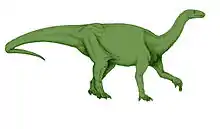Camelotia
Camelotia (meaning "from Camelot") is a genus of sauropodomorph dinosaur from the Late Triassic or Early Jurassic in what is now England.[1][2] Paleontologists are divided on which family it may belong to; in the past, Camelotia has generally been assigned to the prosauropods, but this group of primitive dinosaurs is in constant flux.[1] The genus is now considered a member of the family Melanorosauridae, who includes the first true giant herbivorous dinosaurs.[1][3]
| Camelotia | |
|---|---|
 | |
| Femur | |
| Scientific classification | |
| Kingdom: | Animalia |
| Phylum: | Chordata |
| Clade: | Dinosauria |
| Clade: | Saurischia |
| Suborder: | †Sauropodomorpha |
| Family: | †Melanorosauridae |
| Genus: | †Camelotia |
| Species: | †C. borealis |
| Binomial name | |
| †Camelotia borealis Galton, 1985 | |
| Synonyms | |
| |
Discovery and species
The type specimens, syntypes SAM 3449 and SAM 3450, were described and named in 1985 by Galton. They were collected from the Triassic-Jurassic Westbury Formation, dating to the latest Rhaetian-Lowermost Hettangian.[1][4] The fossils includes the specimens "BMNH R2870-R2874", "R2876-R2878" (holotype), with vertebrae, ribs, and parts of the pubis, ischium and hind limb.[5] The type species, C. borealis, was first described by Galton in 1985. Dinosaurs formerly known as Avalonianus and Gresslyosaurus turned out to be Camelotia.[6]
Description

From the fragmentary remains of Camelotia, part of the skeleton can be reconstructed. Camelotia likely had a short neck supporting a fairly large skull with small eyes. Its jaws contained many small-to-medium-sized, serrated, leaf-shaped teeth.[7] Its hands and feet had five digits each; the hands in particular were long and narrow, and bore a large claw.[7] The forelimbs were longer than the hindlimbs, in contrast to the more derived sauropods.[7] It has been calculated around 9-10 m long.[7][8] On 2020, Rubén Molina & Asier Larramendi pointed Camelotia as the largest known quadrupedal Sauropodomorph, with the holotype measuring 10 metres (33 ft) long, 4 metres (13 ft) tall, and weighed 2.75 metric tons (6,100 lb).[9] Also pointed out that the other Sauropodomorph fossils found on the same location belong to an even larger animal, of 11 metres (36 ft) and 4.70 metric tons (10,400 lb).[9]
References
- Galton, P. M. (1985). Notes on the Melanorosauridae, a family of large prosauropod dinosaurs (Saurischia: Sauropodomorpha). Geobios, 18(5), 671-676.
- Galton, P. M. (1998). Saurischian dinosaurs from the Upper Triassic of England: Camelotia (Prosauropoda, Melanorosaridae) and Avalonianus (Theropoda,? Carnosauria). Palaeontographica Abteilung A, 155-172.
- Buffetaut, E., Suteethorn, V., Cuny, G., Tong, H., Le Loeuff, J., Khansubha, S., & Jongautchariyakul, S. (2000). The earliest known sauropod dinosaur. Nature, 407(6800), 72-74.
- Lomax, D. R., & Tamura, N. (2014). Dinosaurs of the British Isles. Manchester: Siri Scientific Press.
- STORRS, G. W. (1993). Terrestrial components of the Rhaetian (uppermost Triassic) Westbury Formation of southwestern Britain. New Mexico Museum of Natural History and Science Bulletin, 3, 447-451.
- Galton, P. M. (2005). Bones of large dinosaurs (Prosauropoda and Stegosauria) from the Thaetic Bone Bed (Upper Triassic of Aust Cliff, southwest England. Revue de Paléobiologie, 24(1), 51.
- Redelstorff, R. A. G. N. A., Sander, P. M., & Galtom, P. M. (2013). Unique bone histology in partial large bone shafts from Aust Cliff (England, Upper Triassic): an early independent experiment in gigantism. Acta Palaeontologica Polonica.
- Yates, A. M., Bonnan, M. F., Neveling, J., Chinsamy, A., & Blackbeard, M. G. (2010). A new transitional sauropodomorph dinosaur from the Early Jurassic of South Africa and the evolution of sauropod feeding and quadrupedalism. Proceedings of the Royal Society B: Biological Sciences, 277(1682), 787-794.
- Molina-Pérez, R., & Larramendi, A. (2020). Dinosaur Facts and Figures: The Sauropods and Other Sauropodomorphs. Princeton University Press.













